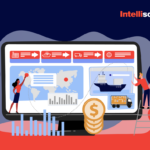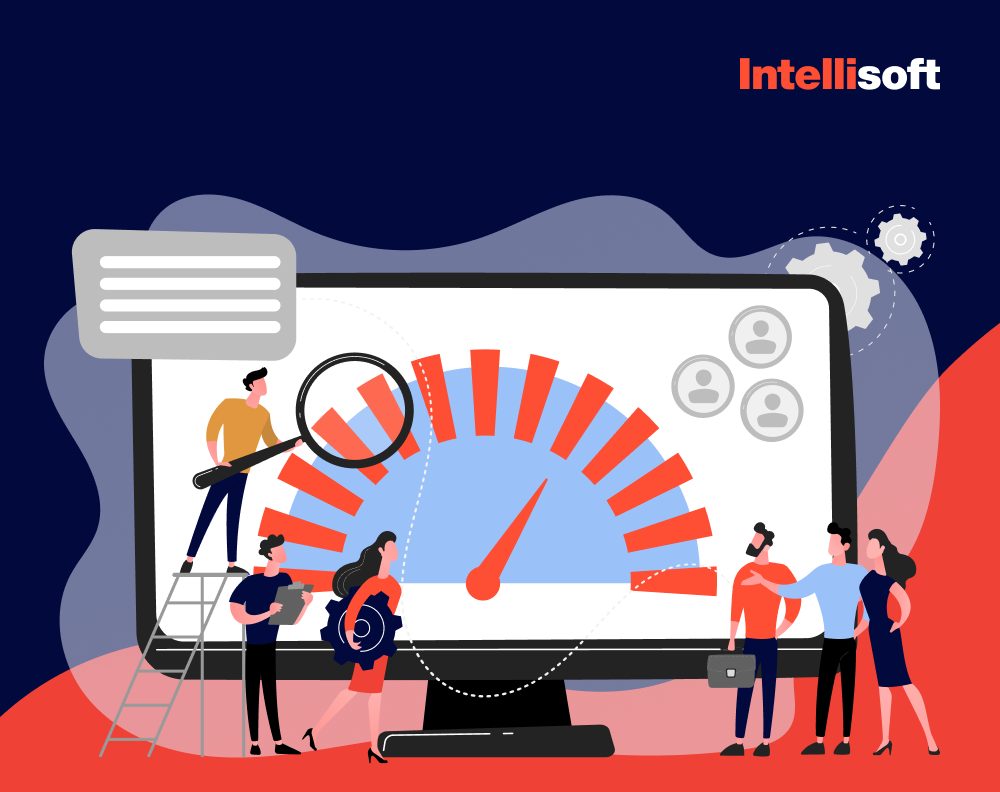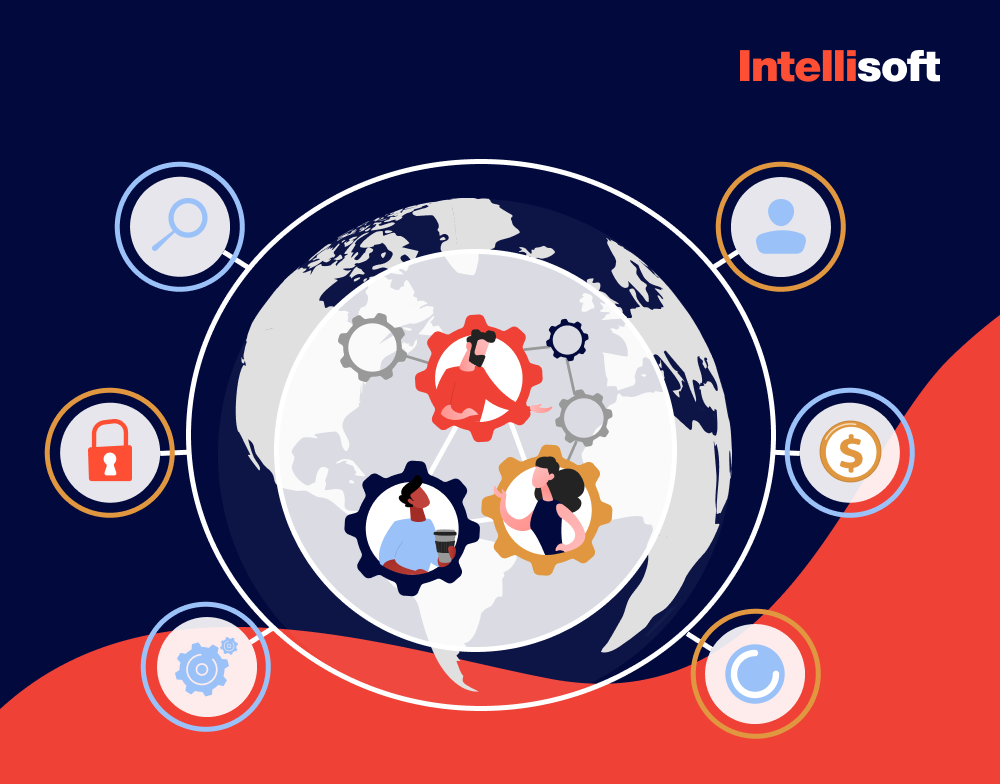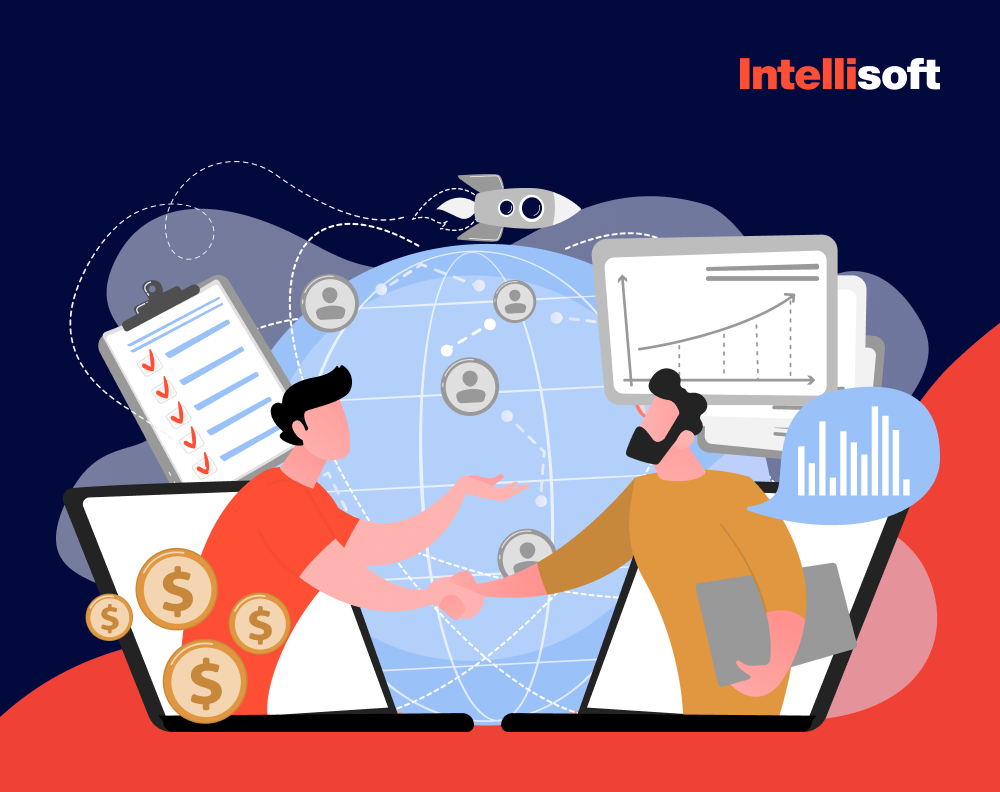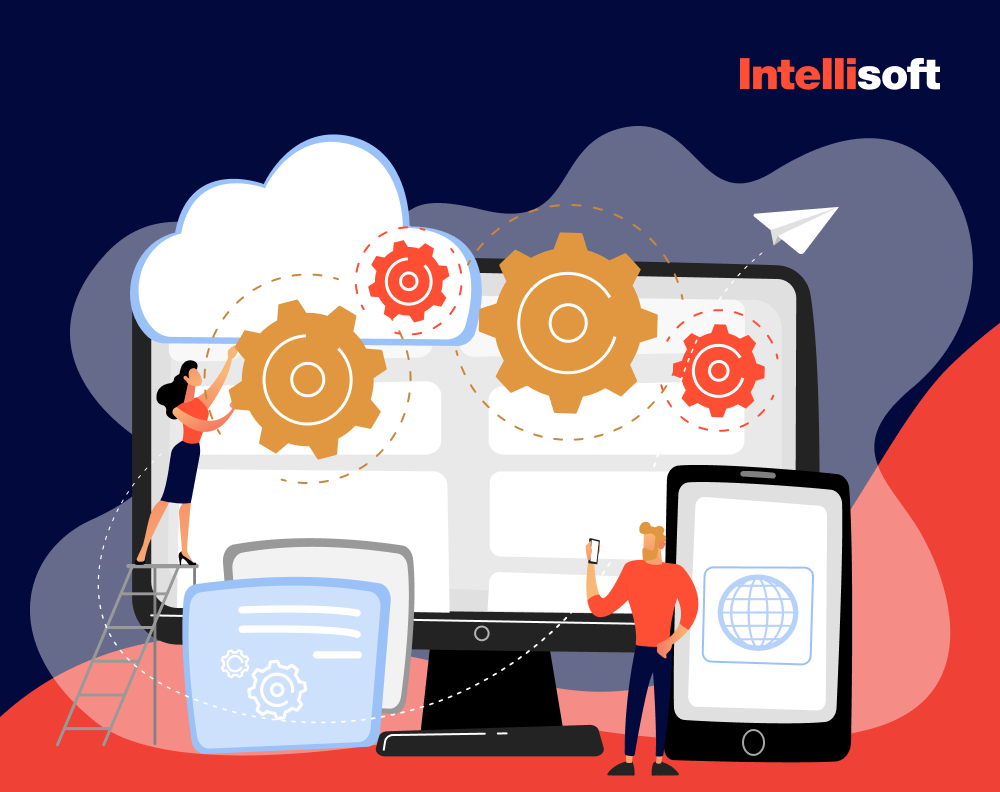According to recent research and statistics, the global outsourcing services market reached $620.381 billion in 2020 and is expected to reach $904.948 by 2027. Businesses of all sizes, from small startups to global enterprises, opt for outsourcing because it allows them to work with top talent for reasonable compensation and focus on their core business processes, so it’s no wonder that the market is steadily growing.
Choosing the right vendor is not an easy task, especially considering the number of experts on the market. Thus, Chief Technology Officers should be armed with effective strategies and tips for selecting the top of the top and ensuring that they are a perfect match for their business. The right skills, talent, expertise, communication skills, and cultural fit – these factors build the basis for a successful partnership, so CTOs should carefully evaluate each candidate before choosing them as a development partner.
In this article, IntelliSoft, with our 15+ years of experience as outsourcing partners, will share the tips and tricks of choosing a perfect vendor and what CTOs always pay attention to. Even if you own a small business and don’t have a CTO, or have no prior experience in selecting vendors, these vendor selection criteria will serve as a guide in this maze of outsourcing.
Table of Contents
Understanding CTO Priorities
Who exactly is a CTO, and why is this person responsible for selecting outsourcing vendors? Let’s explore the CTO’s roles and responsibilities, key priorities in the technological landscape, and how the vendor selection software outsourcing process aligns with CTO goals and objectives.
Overview of the CTO’s Role and Responsibilities
A Chief Technology Officer (CTO) is the executive in charge of an organization’s technological needs as well as its research and development (R&D). This person evaluates short-term and long-term goals for an organization and uses the company’s budget to make investment decisions that will help the business reach these goals.
It is the highest technology executive position within a company as a CTO leads the technology or engineering department. Here are the typical CTO’s responsibilities:
Tech strategy
- Keep a vigilant eye on social and technological trends that have the potential to impact the company’s business objectives.
- Recognize both opportunities and risks that may arise for the business.
- Engage in management discussions pertaining to corporate governance decisions.
- Introduce and execute new processes for data protection and quality assurance.
Research and development
- Conduct research to evaluate, outline, and provide recommendations for the most efficient content management systems.
- Stay up-to-date on the latest information concerning technology standards and compliance regulations.
- Oversee the research and development initiatives related to technology, IT assets, and associated revenue streams.
- Formulate a comprehensive strategy to supervise the integration of new technology within the organization.
- Authorize the implementation of new designs for IT infrastructure and communication systems.
Other responsibilities
- Effectively convey the company’s technology strategy to partners, management, investors, and employees, ensuring clear understanding and alignment.
- Contribute to recruitment, retention, acquisition, and sales endeavors by leveraging technology insights. Cultivate relationships with vendors, communities, and customers to bolster partnerships.
- Regularly oversee and evaluate IT budgets, ensuring their alignment with strategic goals while identifying opportunities for optimization and efficiency.
These responsibilities usually fall into different roles that CTOs play in an organization, including:
- Infrastructure manager. This person takes care of data, security, network, and maintenance. As an infrastructure manager, a CTO implements their company’s technical strategy and technological road maps.
- Strategic planner. CTOs implement the company’s technical strategy and help create new business strategies.
- Consumer liaison. Their key responsibilities encompass managing customer relations, gaining insights into target markets, and actively contributing to the successful delivery of IT projects to the market. This role emphasizes a customer-centric approach, ensuring that technology initiatives directly address and meet the evolving demands and expectations of the consumer base.
- Thinker. They develop corporate strategies and business models while analyzing different target markets.
Key Priorities for CTOs In the Technology Landscape
CTOs should focus on a number of factors to ensure that the company’s tech landscape is healthy and functioning properly, including:
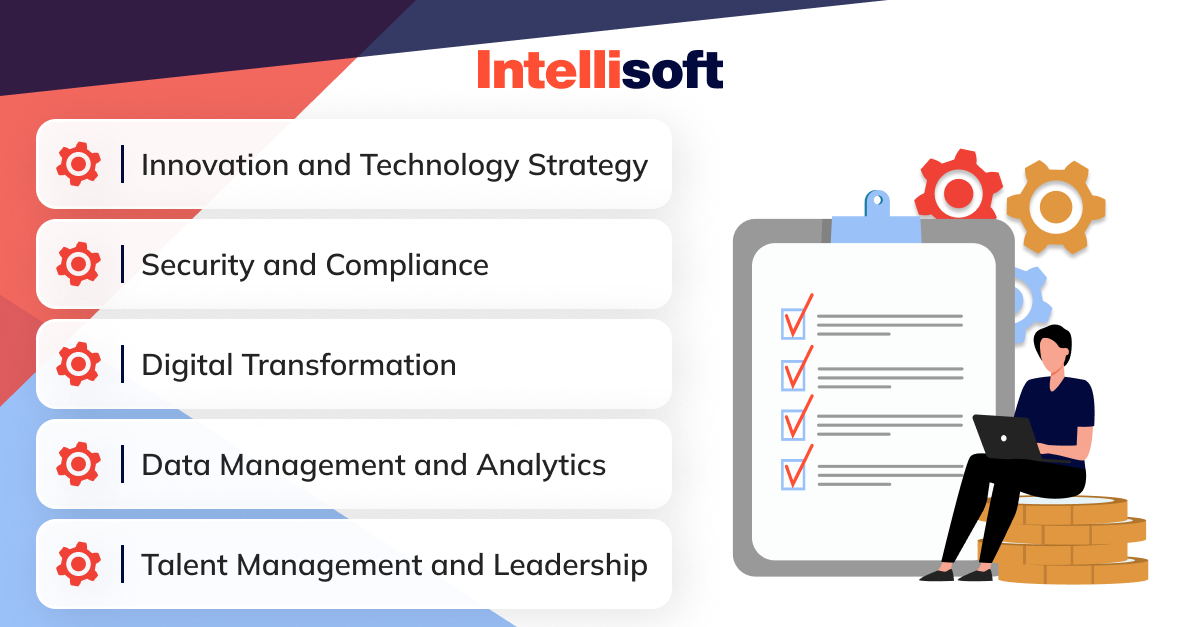
- Innovation and Technology Strategy
The CTO plays a critical role in shaping the organization’s innovation and technology strategy. This involves not only staying ahead of emerging technologies, but also strategically incorporating them into the company’s roadmap. A successful CTO promotes a culture of innovation, encouraging experimentation and creative problem-solving. They collaborate with other executives to ensure that the technology strategy aligns seamlessly with the overall business objectives. Additionally, they assess the long-term impact of technological trends to position the company as a leader in its industry. - Security and Compliance
In an era of increasing cyber threats, the CTO must prioritize the security of the organization’s digital assets. This involves implementing robust cybersecurity measures, conducting regular security audits, and staying informed about the latest threats. The CTO also ensures that the organization complies with relevant data protection and privacy regulations. Beyond technological safeguards, the CTO educates employees on security best practices and fosters a security-conscious culture throughout the organization. - Digital Transformation
CTOs are the main drivers of digital transformation initiatives. They modernize legacy systems, embrace cloud technologies, and integrate digital solutions into various business processes. Successful digital transformation under the guidance of a CTO results in improved operational efficiency, enhanced customer experiences, and a more agile and adaptive organizational structure. The CTO collaborates with other leaders to identify areas where technology can deliver the most significant business value and oversees the successful execution of transformation projects. - Data Management and Analytics
The effective utilization of data is a critical priority for CTOs. They develop and implement comprehensive data strategies to collect, store, and analyze data for actionable insights. This involves investing in advanced analytics tools and creating a data-driven culture within the organization. The CTO ensures that data governance practices are in place, balancing the need for accessibility with security and compliance requirements. By harnessing the power of data, CTOs empower their organizations to make informed decisions and gain a competitive edge in the market. - Talent Management and Leadership
Building and leading high-performing technology teams is a cornerstone of a CTO’s responsibilities. Beyond technical expertise, the CTO fosters a collaborative and innovative culture within the technology department. They play a crucial role in talent acquisition, identifying and hiring individuals with the right skills and cultural fit. Additionally, the CTO invests in continuous learning and professional development to keep the team’s skills up-to-date. A strong emphasis on leadership ensures that the technology team aligns with the broader organizational goals, contributing meaningfully to the company’s success.
How Vendor Selection Software Outsourcing Process Aligns with CTO Goals and Objectives
Selecting the right vendor is a strategic process that should align with the CTO’s main goals and objectives. Since a CTO is an expert who determines the tech landscape of their organizations, the decisions they make about vendors influence the entire organization, so the choice of a development partner should align with the goals and objectives of a CTO and the entire company.
Here’s how vendor selection software outsourcing process aligns with CTO goals and objectives:
Technology Strategy Alignment. A CTO will select vendors whose services align with the organization’s tech strategy. This helps ensure that the vendor will contribute to the technological vision of the company and support its long-term goals.
Innovation and Scalability. CTOs evaluate vendors based on their commitment to innovation and the scalability of their solutions. Choosing vendors with a track record of adapting to technological advancements ensures that the organization can evolve its technology stack to meet changing business needs.
Security and Compliance. CTOs prioritize vendors with robust security measures and a commitment to compliance. The selected vendors should align with the organization’s standards for data protection, privacy, and overall cybersecurity, contributing to a secure and compliant technology ecosystem.
Cost-Effectiveness and ROI. CTOs assess the cost-effectiveness of vendor solutions, considering not only the initial investment, but also the total cost of ownership. Vendors that offer value for money, contribute to operational efficiency, and provide measurable ROI are the preferred choice.
Digital Transformation. CTOs choose development partners who support the company’s digital transformation goals. This involves selecting partners who offer cutting-edge technologies, integration capabilities, and a roadmap that aligns with the organization’s transformation journey.
Risk Management. CTOs assess the risks associated with each vendor, considering factors such as reliability, reputation, and financial stability. By selecting vendors with a strong risk management profile, CTOs contribute to the overall resilience of the organization’s technology ecosystem.
Related Readings:
- Nearshoring. What is it, and for Who?
- What is Staff Augmentation? A Model to Extend Your Team
- Outsourcing vs. Outstaffing Models: What Is the Difference and Their Pros & Cons
- Everything You Need to Know About Team Extension and Dedicated Team Models
- 10 Best Countries for Hiring a Dedicated Development Team
What Matters the Most for CTO When Selecting an Outsource Partner?
During the vendor and software selection, CTOs pay attention to several of the most important factors that help them see whether a candidate is a match for the company. Here is what matters the most for CTOs when selecting a vendor:
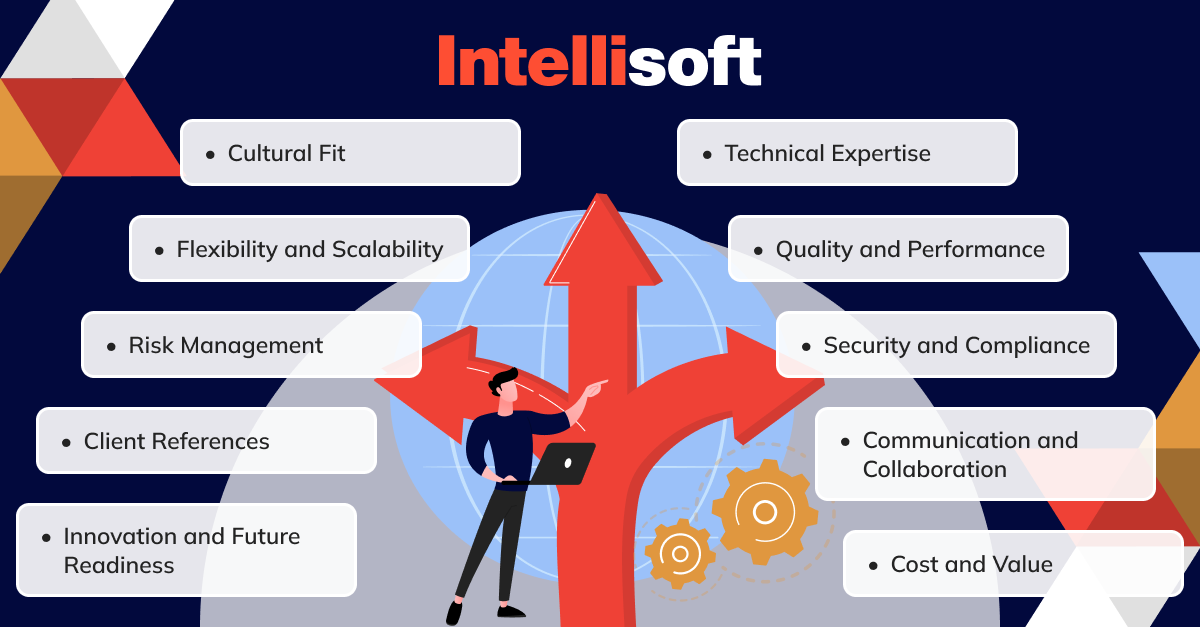
Technical Expertise
First and foremost, CTOs are looking for an exceptionally high level of technical expertise. The outsourcing partner should have a skilled and experienced team of experts ready to handle projects of various complexity and work on any type of project. Moreover, the vendor should have a deep understanding of the industry, trends in the market, and the latest technologies.
Quality and Performance
Expertise is essential, but the vendor should also demonstrate that their team maintains high-quality standards and is ready to deliver a product of top quality. Thus, a CTO checks vendor’s quality assurance processes, testing methodologies, and commitment to delivering solutions that meet all requirements and exceed industry standards. CTOs also always evaluate performance metrics (KPIs) such as response times and system efficiency. Finally, it is important to check a vendor’s previous cases and read clients’ reviews on websites like Clutch and LinkedIn.
Security and Compliance
Nowadays, the security of the data is, perhaps, the main priority of all CTOs. The chosen outsourcing partner should demonstrate a comprehensive approach to security by applying a number of security practices; coding practices, data encryption, and robust access control. Moreover, it is critical to comply with the industry’s latest regulations and data protection laws, so the CTO should double-check whether a vendor adheres to these standards.
Communication and Collaboration
Effective communication is the backbone of a successful outsourcing partnership. The CTO should assess the partner’s communication channels, responsiveness, and project management tools. Clear lines of communication, regular updates, and the ability to collaborate seamlessly are essential for overcoming potential challenges and ensuring the project’s success.
Cost and Value
While cost is a significant factor, the CTO should look beyond the initial price quote. It’s essential to evaluate the overall value the outsourcing partner brings to the table. This includes factors such as the partner’s ability to deliver on time, the quality of their work, and how well their services align with the company’s strategic objectives.
Cultural Fit
Technical expertise, and a bunch of successful cases, are not the only factors that matter for a CTO. Cultural alignment with the company and its values is critical for a successful relationship as well. The CTO should assess whether the outsourcing partner shares similar values, work ethics, and business practices. A cultural fit promotes better collaboration and understanding, reducing the likelihood of misunderstandings or conflicts during the project.
Flexibility and Scalability
Project requirements often evolve, and the outsourcing partner should be flexible enough to adapt. The CTO should evaluate the partner’s ability to scale resources up or down based on project needs. Flexibility is essential for accommodating changes in scope, timeline adjustments, and addressing unforeseen challenges.
Risk Management
A proactive approach to risk management is crucial for project success. The CTO should assess how the outsourcing partner identifies and mitigates risks. This includes having contingency plans in place, transparent communication about potential challenges, and a demonstrated ability to navigate unforeseen circumstances without compromising project delivery.
Client References
Client references provide valuable insights into the outsourcing partner’s track record. The CTO should seek references from organizations with similar project requirements to understand the partner’s reliability, communication style, and overall satisfaction of past clients. This due diligence helps in making an informed decision.
Innovation and Future Readiness
An outsourcing partner should meet current project requirements and showcase a commitment to innovation and continuous improvement. The CTO should inquire about the partner’s approach to adopting emerging technologies, staying updated on industry trends, and contributing innovative ideas that could benefit the company’s projects in the long run.
Essential Vendor Selection Criteria for CTOs
The process of vendor selection is complex and often confusing, especially if you, as a CTO, have no prior experience in it. What are the essential vendor selection criteria? What should you pay attention to? Let’s explore what vendor and software selection criteria to assess when choosing a software outsorcing vendor.
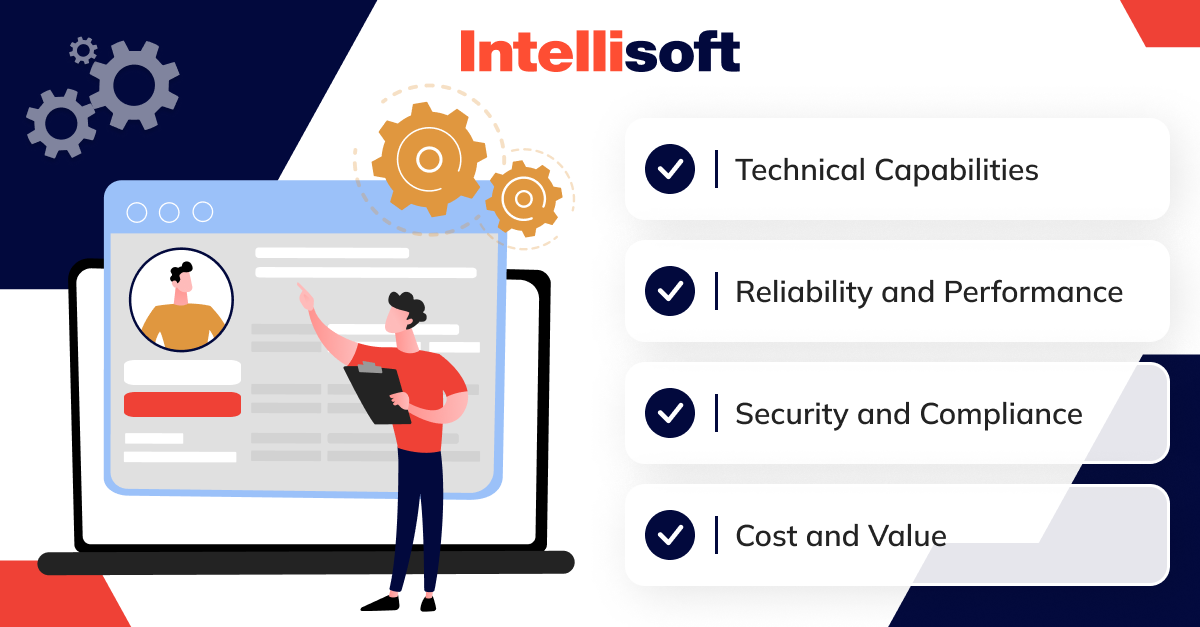
Technical Capabilities
The cornerstone of any successful collaboration with a vendor is their technical expertise, so that’s what CTOs pay attention to the most. First, a CTO evaluates a vendor’s depth of knowledge proficiency in relevant technologies, programming languages, and frameworks. Moreover, a CTO checks the track record of successful projects to ensure that the team can handle various tasks.
Another important factor is the vendor’s compatibility with the company’s existing technology stack. This compatibility ensures smooth integration and minimizes potential issues. Finally, the CTO should assess the vendor’s commitment to innovation and their ability to adapt to emerging technologies. This includes an evaluation of the vendor’s approach to staying ahead of industry trends and easily incorporating new solutions.
Reliability and Performance
Another crucial factor for project success is the vendor’s reliability and performance. Thus, a CTO should check references, case studies, and analyze a vendor’s historical performance to understand the level of the vendor’s reliability. Feedback from previous clients allows a CTO to gain valuable insights into the vendor’s track record.
The CTO should also analyze essential KPIs such as response times and scalability, comparing them to industry standards and analyzing whether the vendor’s performance meets market expectations. Scalability is vital for accommodating future growth, so a CTO should ask about the vendor’s capacity planning, resource scaling strategies, and long-term plans for handling increased workloads.
Security and Compliance
When selecting a vendor, CTOs always pay close attention to the candidates’ security policies, data encryption methods, and incident response procedures. The CTO should ensure that the vendor has robust measures in place to protect sensitive data.
Moreover, it is important to verify the vendor’s compliance with industry regulations, and whether they have all the necessary certifications. Thus, CTOs may ask for audit reports as additional proof that the vendor is committed to security and compliance. The CTO should also assess the vendor’s data handling practices, privacy policies, and access controls to safeguard sensitive information.
Cost and Value
Requesting a detailed breakdown of costs, and understanding the billing structure, helps ensure transparency. The CTO should assess whether the pricing model aligns with the company’s budget and provides clarity for financial planning.
Moreover, a CTO should evaluate the total cost of ownership over the project’s life, identify potential hidden costs, and conduct a thorough analysis of the return on investment (ROI).
Finally, the CTO should consider the vendor’s post-launch support, maintenance offerings, and any additional services that enhance the overall value of the partnership. Training programs for in-house teams contribute to the long-term success of the collaboration.
Step-by-Step Guide for CTOs In the Software Vendor Selection Process
Selecting an outsourcing development partner is a multi-step process that differs depending on your requirements and capabilities. In most cases, it consists of six main stages: Requirements gathering, research, the request for proposal and analysis, evaluation, and decision. Let’s take a look at all those stages:
- Requirements gathering. First of all, you need to understand what your expectations from the cooperation are, what are your main requirements for the vendor, and what tasks will be delegated. Outline your priorities, needs, and expectations, and choose software vendor selection criteria.
- Research. Once you have the requirements and software vendor selection criteria in place, it’s time to study the market. You can identify potential candidates by googling, browning ranking services, or checking Clutch.
- The RFP and analysis. Creating an RFP means describing your business, outlining your requirements, and specifying your market goals. Moreover, you should clearly state the technical requirements, timelines, and any other relevant information. Remember to include evaluation criteria and key performance metrics (KPIs). Then, when you receive information about potential vendors, you need to analyze it thoroughly. You should evaluate received proposals based on your predetermined software vendor selection criteria, analyze whether the vendors understand your requirements and needs, and check the candidates’ past cases, existing clients, and their overall experience.
- Evaluation and decision. Conducting Q&A sessions is a standard practice for assessing potential software development partners during the evaluation and decision phase. While preliminary stages provide a broad understanding of each company’s approach to your project, it’s crucial to delve deeper into the specifics during this phase. This involves gathering more information about how each vendor plans to meet your requirements, seeking details on their software development process, and evaluating communication ease.
Involvement of Key Stakeholders in Decision-Making
During the software vendor selection process, the active involvement of key stakeholders is essential for CTOs aiming to align external partnerships with their organization’s technological and strategic goals. The insights and perspectives of these stakeholders contribute to a comprehensive evaluation process, ensuring that the selected vendor not only meets technical criteria, but also resonates with the overall vision of the company.
Here are the steps you should take to involve stakeholders in the process:
Step 1: Identify key stakeholders
First, identify and involve key stakeholders, including CTOs, project managers, and department heads. You should also ensure representation from various levels of the organization to capture diverse perspectives.
Step 2. Strategic collaboration in requirements definition
Facilitate collaborative sessions where key stakeholders actively participate in defining the specific technical and strategic requirements for the outsourcing partnership, and incorporate their insights into the selection criteria to ensure a holistic evaluation.
Step 3. Continuous updates and feedback
Maintain a transparent communication channel, providing regular updates on the vendor selection progress and encouraging a continuous feedback loop to address concerns, refine expectations, and adapt the selection criteria accordingly.
Step 4. Decision workshops
Conduct decision-making workshops that involve key stakeholders and align discussions with the organization’s strategic goals, ensuring that the chosen vendor contributes to the broader mission.
Step 5. Risk assessment and mitigation collaboration
Collaborate with stakeholders to assess and address potential risks associated with outsourcing and develop risk mitigation strategies that align with the organization’s risk tolerance.
Step 6. Legal and compliance alignment
Next, engage legal and compliance teams in reviewing contracts and agreements. You should also ensure that the selected vendor adheres to industry regulations and aligns with organizational policies.
Step 7. Holistic communication plan
Finally, develop a comprehensive communication plan that keeps stakeholders informed at each stage of the software vendor selection process. Address any concerns promptly to maintain confidence in the decision-making process.
Importance of Pilot Projects and Proof of Concept in Vendor Selection Criteria
Within the context of vendor selection, incorporating pilot projects and proof of concept (POC) into the criteria is a strategic move by CTOs. These initiatives serve as tangible demonstrations of a vendor’s ability to meet technical requirements, adhere to timelines, and provide evidence of their capacity to deliver high-quality outcomes.
Here are some key reasons why they are important:
Risk Mitigation
Pilot projects allow organizations to assess the actual capabilities and performance of a vendor’s solution in a real-world environment, helping to identify and mitigate potential risks before committing to a full-scale implementation.
Validation of Vendor Claims
Vendors often make claims about the effectiveness and efficiency of their solutions. Pilot projects provide an opportunity to validate these claims in a controlled setting, allowing the organization to make informed decisions based on real-world results.
Customization and Fit for Purpose
Pilot projects enable organizations to evaluate how well a vendor’s solution aligns with their specific requirements and business processes. This helps in understanding the need for customization and ensures that the chosen solution is a good fit for the organization’s unique needs.
User Acceptance Testing (UAT)
Pilot projects involve end-users in the testing process, allowing organizations to gather feedback on the user experience and identify any usability issues. This user acceptance testing is critical in ensuring that the solution meets the needs and expectations of the intended users.
Cost-Benefit Analysis
By implementing a pilot project, organizations can conduct a detailed cost-benefit analysis. This includes assessing the initial costs, ongoing expenses, and potential return on investment (ROI). This financial evaluation is crucial for making informed decisions on whether to proceed with a particular vendor.
Proof of Feasibility
Pilot projects serve as proof of the feasibility of implementing a vendor’s solution within the organization’s existing infrastructure. This is particularly important for complex technologies or solutions that may have dependencies and integration challenges.
Stakeholder Alignment
Pilot projects provide an opportunity to align stakeholders, including both decision-makers and end-users, on the goals and expected outcomes of the project. This alignment is essential for successful implementation and user adoption.
Conclusion
Hiring a reliable software development partner can be your key to overcoming the shortage of skills and expertise in your company and receiving a high-quality product or service while saving money. However, it is only possible if you invest time and effort into the vendor selection process and evaluate each candidate thoroughly.
Fortunately, you don’t have to come up with a plan for the selection process all by yourself and wonder whether you have forgotten something essential. There exist numerous criteria lists that CTOs use to select vendors, and you are more than welcome to use them to guide you through this process. Yet, remember to adjust your selection process to your organization’s needs and capabilities.
IntelliSoft has been working as an outsourcing partner for more than 15 years and we know exactly what businesses are looking for, so we can help you come up with your own criteria for vendor selection and guide you through the process. Contact us, and you will experience all the benefits of delegating tasks to outsourcing vendors.
